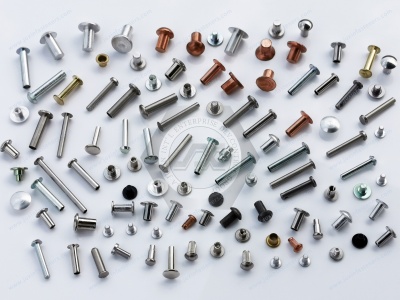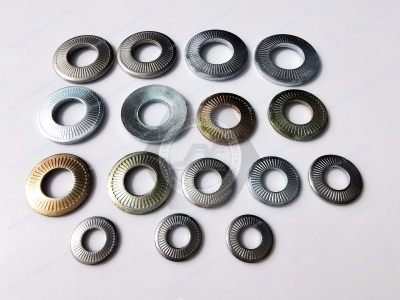Call Us
+86 136 6007 9809
Call Us
+86 136 6007 9809
Jan. 13, 2024
The role of rivets and the use of industry solutions
The Role of Rivets Industry Solutions
Mil. Spec. Aluminum Flush-Mount Solid Rivets: Made of heat-treated aluminum, these rivets meet MIL-C-5541. They are lightweight, nonmagnetic, and chemically treated for good corrosion resistance, leaving a gold-colored finish. It is installed in a countersunk hole, and the angled head sits flush with the material's surface.
Installation of solid rivets requires access to both sides of the material and a hammer or a reliable rivet tool. To achieve the most consistent results and a professional appearance, we recommend using a riveting air hammer with a rivet setter that matches the rivet's head style and a bucking bar.
18-8 Stainless Steel Domed Head Solid Rivets:18-8: stainless steel rivets are more corrosion resistant than those made of aluminum, brass, or copper and may be mildly magnetic.
Installation of solid rivets requires access to both sides of the material and a hammer or a reliable rivet tool. To achieve the most consistent results and a professional appearance, we recommend using a riveting air hammer with a rivet setter that matches the rivet's head style and a bucking bar.
Rivet is a method to replace the screw connection so that multiple parts are connected, both fastening, but also to enable the parts to rotate (using step rivets). Method of use:
1. Can be manually riveted, not high efficiency, suitable for small batch production;
2. It can be machine riveted, and people and machines with high production efficiency, suitable for mass production, to achieve semi-automated operation, is 5-10 times the efficiency of manual riveting. It can significantly reduce production costs and shorten the production cycle. Cost-effective is the use of screws cost 1/4, 3 times faster than the screw connection speed. (Buy screws you have to buy nuts) which increases the cost, even if you use the electric batch or wind batch on the screws, but also faster than the riveting machine riveting. People who have used rivets know that the structure can use rivets will be used because you can save unnecessary expenses. Improve the competitiveness of your products! In our usual use of sheet metal chassis cabinets in the process, we can find sheet metal chassis cabinets have a lot of rivets, so what role do these rivets have? These rivets ensure the firmness of the sheet metal enclosure cabinet connection. Then, in such a situation, we have specific requirements for it:
A. Industrial aluminum profile structural frames that can be applied to high-end technical settings;
B. Square steel framing systems that can be used in vibration environments;
C. Aluminum profiles and sheet metal structural framing systems that can be applied to powerful line management and equipment installation.
Rivet performance characteristics
1. Anti-shear performance: Rivets are mainly subject to shear force in the structural connection of aerospace products; therefore, the general rivet standard stipulates the minimum destructive shear index of rivets. With the improvement and standardization of test methods, more and more standards specify double-shear indicators. Compared with single-shear, double-shear test results are more accurate and reliable.
2. Riveting performance: riveting refers to the riveting completed after riveting into the head molding requirements. The excellent or lousy molding of the riveting head directly affects the quality of the riveting. Therefore, in the domestic aerospace industry, riveting standards have strict requirements for riveting, while the general purpose of ordinary rivets has not yet specified riveting requirements. Rivetability and strength are two contradictory indicators; the higher the strength, the worse the rivetability. In general, the height of the riveted head after riveting is 0.35d-0.4d, with a riveted head diameter of 1.4d or more. At the same time, the riveting head cracks have strict requirements: cracks are only allowed to appear in the riveting city cast column surface, can not be penetrated to the top surface, the total number of not more than 3, and width and depth of not more than 0.07mm.


The use and types of rivets:Semi-circular head rivets are mainly used for riveting occasions with larger lateral loads and are the most widely used.
Due to fat nail head and corrosion resistance, flat cone head rivets are commonly used in ship hulls, boiler tanks, and other corrosive, robust riveting occasions.
Countersunk head 120-degree countersunk head rivets are mainly used for smooth surfaces, with no heavy riveting.
Semi-countersunk head, 120 degrees semi-countersunk head rivets are mainly used for smooth surfaces, with the load not big riveting occasions.
1. Flathead rivets are used for riveting occasions with general load.
Flathead, round head rivets are mainly used for sheet metal or leather, canvas, wood, and other non-metallic riveting occasions.
2. Large flathead rivets are mainly used for non-metallic materials riveting occasions.
Semi-hollow rivets are mainly used for riveting occasions where the load is insignificant. The option of its head type can refer to the above introduction of various solid rivets.
3. Headless rivets are mainly used for non-metallic materials riveted occasions.
Hollow rivets are lightweight, the nail head weak, and used with the load, not large non-metallic materials riveted occasions.
Tubular rivets are used for non-metallic materials that do not follow the load of riveting occasions. Rivets are mainly used for riveting machines, equipment, etc., above the nameplate.
4. Blind rivets are a class of single-sided riveting with rivets, but special riveting tools (manual, electric, the move) must be used for riveting. These rivets are particularly suitable for the inconvenience of using ordinary rivets (to be riveted from both sides) on riveting occasions; it is widely used in construction, automobiles, ships, airplanes, machines, electrical appliances, furniture, and other products. One of the most commonly used open type flat round head blind rivets, countersunk head blind rivets are suitable for riveting occasions where the performance needs to be smooth; closed type blind rivets are ideal for riveting occasions where the requirements with a higher load and a certain degree of sealing performance.
5. Strike core rivets are another type of single-sided riveting rivets, riveting with a hammer to strike the head of the rivet to reveal the core so that it is flush with the end of the nail head, that is, to complete the riveting operation, it is very convenient, especially for the inconvenience of using ordinary rivets (riveted from both sides) or core-pulling rivets (the lack of riveting gun) riveting occasions. Often used flat round head core riveting, countersunk head core riveting suits surfaces that need smooth riveting.
18-8 stainless steel rivets are more corrosion-resistant than those made of aluminum, brass, or copper and may be mildly magnetic.
Installation of solid rivets requires access to both sides of the material and a hammer or a reliable rivet tool. To achieve the most consistent results and a professional appearance, we recommend using a riveting air hammer with a rivet setter that matches the rivet's head style and a bucking bar.
If you are looking for high-quality 18-8 stainless steel flathead solid Rivet fasteners or technical support for structural design, please get in touch with me. Thanks.Email:adelajonly@gmail.com
Website: https://www.juxinfasteners.com
Contact Us
Tel.:
+86 020 8621 0320
+86 020 3121 6067
Technical Support:
Navigation
SEND INQUIREY